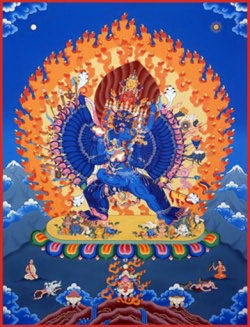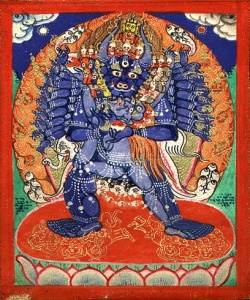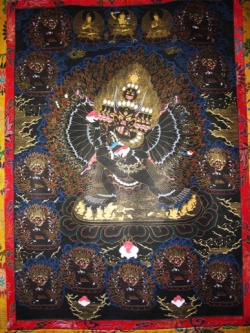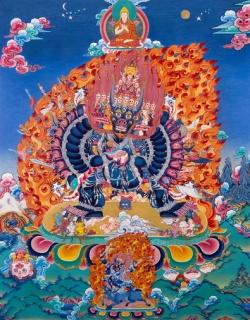Advice to a Yamantaka Initiate
Transcript for ”Advice to a Yamantaka Initiate”.
Transcribed by Tenzin Losang
Proofread by Sarah Yap
Buddha has given many sets of teachings, and they compose of sutra and they compose of tantra. And the reason that Buddha gave the different types of teachings of sutra and tantra is to suit the different types of mental, karmic, environmental and time dispositions. So environmental, meaning place, time meaning how far away it is from the Buddha first turned the wheel of Dharma to the end of the Dharma, which is 5,000 years.
And also individual, meaning the aptitude of the person, and karmic dispositions, means their previous life connections and their ability and their need to practice. So therefore, Buddha gave two sets of teachings according to these four types of principals. Hence, within this, the Sutra path is much longer. The Sutra path is longer not because the Sutra is slow, the Sutra path is longer is because the Sutric method is less challenging, less pushy and less demanding.
Hence, the person finds it much easier. But the long term disbenefit is that it will take you much longer to become an Enlightened being. Whereas in tantra, it’s much more challenging, it’s more difficult and it’s much more, it pushes you more, and it challenges you more, but the benefit is that you are able to become Enlightened faster. Hence within the tantric system, you have four sets of tantras: Charya, Yoga, Kriya and Maha Anuttara tantra.
Within, within the four, the highest is the Maha Anuttara tantra. Within the Maha Anuttara tantra, you have two divisions again, ma rgyud and pha rgyud, ma rgyud is mother tantra, pha rgyud is father tantra. So, mother tantra and father tantra, both can bring you to Enlightenment, but they focus on different types of afflictions to be converted. So, within the mother tantra you focus on “clear light”, within the father tantra you focus on “illusory body”
So, for example, the higher father tantras are like, higher mother tantras are like Kalachakra, Heruka, the higher father tantras are, for example, like, Guhyasamaja. They’re all very qualified paths, it’s just depending on the method. So hence, within the father and the mother you have these divisions, but, what is most superior, and what is most powerful, and what is most extremely beneficial is a combination of mother and father tantra.
So, the only higher tantric system that focuses on both mother and father combined simultaneously is the Yamantaka set of tantras. So Yamantaka sets of tantras are very, very powerful because they focus on both clear light and illusory body, simultaneously. Then within that, Yamantaka’s tantra was not very popular although existent, prior to the King of Dharma, the Second Buddha, Gyalwa Nyipa, Tsongkhapa. So the Second Buddha is called Gyalwa Nyipa. Second Buddha means the one that’s equal to Sakyamuni after Sakyamuni. Alright?
It was existent but not popular till Lama Tsongkhapa himself found various types of Yamantaka tantras, example, from the Kagyu and the Sakya. He practiced it, and he achieved visions, and he achieved results. So, therefore out of the various sets of Yamantaka tantras, he took out two sets of Yamantaka tantras. One is Pawo Chigpa, is Solitary Hero, Solitary Hero, Solitary Vajra Terrifier, and then the other one is (Tibetan name) or Thirteen Deity Yamantaka. Either one is very good.
Now, within the Yamantaka tantras, it is, Lama Tsongkhapa kept that as his personal yidam, along with other higher yidams, and he practiced it and he gained results. He himself wrote commentaries, his students also wrote commentaries on the practice of Yamantaka, and hence today the Yamantaka practice is very prevalent, very powerful and extremely widespread because of these great writings and Lama Tsongkhapa’s own personal practice.
So Lama Tsongkhapa himself practiced and gained results, and hence he recommended his students to do it. So I hear that you have Yamantaka’s teachings. I’m very, very happy, and I’m very pleased to hear that. Yamantaka’s tantra, (Tibetan words], means it has seven special attributes, seven special attributes. I will name a few for you now.
One of the attributes of Yamantaka is, no matter how much negative karma we have collected, no matter how much negative deeds we have done, no matter how much suffering we have created for others, if we sincerely regret, and we do Yamantaka’s tantra, within one single short lifetime, we can purify that negative karma. So, no other tantra, no other tantric system, no other sutra system, can promise us to purify, example, even if we have created the most heinous crimes. Heinous. Such as killing one’s father and mother, drawing blood from a Buddha, or creating schism in the Sangha, those are heinous crimes, where when you die, there is no Bardo, you immediately die, you close your eyes, when you open it, you are born in Hell.
So even the most heinous crimes, if we do Yamantaka’s tantra very well, we can purify in one life. That is symbolized by Yamantaka’s set of hands, on the left side set of hands, you will see one row, one row, one hand is holding one man impaled on a stick. That man impaled on a stick represents the result of negative karma and the incredible sufferings that we have to endure. So, that type of suffering that we have to endure, by Yamantaka holding that man on a stick, represents that even some karma that means you have to really go to the Three Lower Realms, to Hell to suffer, you can purify through Yamantaka tantra.
So he is that powerful. So therefore if we have created something very negative, very powerfully negative, imagine what Yamantaka can help us in. So if we didn’t do that, imagine how powerful Yamantaka is, even still. Secondly, Yamantaka is the most ferocious out of all the deities existent within the Tibetan pantheon of Buddhas. The most ferocious, the most wrathful is Yamantaka. No other deity is more wrathful than Yamantaka.
The benefit of that is, that if we do Yamantaka’s practice, we can overcome our inner, real, self-grasping anger. Anger that arises from self-grasping, can be reduced and can be destroyed, can be purified. So hence, that’s very, very important. And also, no other deities, spirits, gods, of the sky, male, female, earth, whatever, or even other protectors can overcome a practitioner of Yamantaka or one who has achieved Yamantaka.
One who has achieved Yamantaka, they simply say, “I am Yamantaka”. Interferences that are supernatural in nature, magic, ghosts, spirits, cannot disturb that person, cannot disturb that person that he has blessed, or she has blessed. So, Yamantaka’s practice is very powerful for protecting oneself against negative, destructive energy.
Number three. The binding factors that keeps us in Samsara is, ignorance. That ignorance is, is manifested as grasping of the “self” that does not exist. So for us to realize that, for us to understand that intellectually is easy. But if it’s, if things change because we understand, then things would have changed because many people understand that point once they have studied Buddhism.
But just understanding it doesn’t make you change but realizing it and it becomes second nature will provoke change. So, hence, many things we do come from second nature that are embedded within our mindstream for many lifetimes. Hence, that’s called habituation. So Yamantaka’s practice is very, very powerful, extremely, extremely powerful for removing the self-grasping “I” that doesn’t exist.
So to achieve emptiness, Yamantaka is the most profound and the most quickest. By virtue he is purely 100% Manjushri and no other. So hence, it has those kind of benefits. Another benefit is within Yamantaka’s tantra, within Yamantaka’s tantra, if you practice, it is said that you do not need to practice any other tantras whatsoever, no other tantra is necessary to become Enlightened. With Yamantaka’s tantra alone one can become fully Enlightened.
Along with practising Yamantaka’s tantra, one can perfect memory, clairvoyance, penetrative insight, one can have great debate, one can have great speech, one could have perfect understanding of the Dharma. And one collects great amount of merit while one is perpetuating Yamantaka. One collects a great amount of merit. So hence, while we’re practicing Yamantaka we’re not also practicing only tantra, we’re practicing sutra because Yamantaka’s path combines both sutra and tantra.
Hence, if you do Yamantaka’s practice and you combine it with the four preliminary practices such as offerings, mandala, prostrations, Vajrasattva, etc. everything is 100% complete. So like that there are many, many, many, many benefits to doing Yamantaka’s tantra. There are many, many powers to doing Yamantaka’s tantra. If one has time, one should do the long Yamantaka tantra, one should do the long Yamantaka sadhana, every single day that one can.
If one doesn’t have time, one should do the short Yamantaka sadhana which is about eight or, seven or eight small pages, written by the great Kyabje Pabongka Dechen Nyingpo Rinpoche. So, this one you can do either the short one, you can do the long one, it’s up to you. And every single day one should make biscuits and cookies, offer one main biscuit, one main cookie to Yamantaka and two smaller ones, one to the entourage and one to the Directional Protectors at the end of the sadhana.
So one can do a Yamantaka torma, an entourage of Yamantaka torma, and a ten wrathful deity which you will see in a sadhana torma. And along with that, it would be very, very good for us, to also have an inner offering, meaning for Yamantaka’s practice it’s very important to have an inner offering, you can either use a small bit of alcohol or black tea, either way with a qualified Rilbu. Rilbu means qualified inner nectar pill put inside.
Then one should do, use a inner offering every single day, as part of the practice and make torma offerings, also two sets of sensory offerings and the sets of sensory offerings is very important. It’s
OM YAMANTAKA ARGHAM, PADYAM, GHENDE, PUSHPE, DHUPE, ALOKE, NAIWITYE, SHABTA PRATICCHA HUNG SOHA.
Whereas in other tantras it’s OM, whatever deity,
ARGHAM, PADYAM, PUSHPE, DHUPE, ALOKE, GHENDE, NAIWITYE, SHABTA PRATICCHA HUNG SOHA.
So in the sensory offerings Yamantaka, the GHENDE, or the perfume is after the flower. Okay? Before the fire. So that’s a little bit different. You should offer two sets, of the offering every single day and recite the Yamantaka mantra, the first one, the second one, 21 times or more but you should focus on the third mantra. The root mantra, the third one you should do as much as possible even while you’re watching TV and you’re free, you can do that mantra.
Then the last mantra, you can do 21 times again. So every single day, the bare minimum for the first, second and fourth mantra, is 21 times. The third mantra is 21 but if you can do more it’s much, much, much, much better. Then do a very powerful dedication, to Yamantaka at the end and that will be very good.
So I have received your wonderful offering, and I thank you. I’ve made offerings to Manjushri for you, for the success of your practice. So because you’ve made this offering it inspires me to give you a little bit of information, a little bit of talk and explanation of Yamantaka, which should be translated to you, and you can listen to it very carefully. If you like, this, this also can be burned. My speech, although it’s in English can be burned into a CD and sent to you by email so you can keep it for future reference if you like also.
Otherwise, I wish you the best. I encourage you to have good Guru Devotion. Please read, please read and it’s in Chinese also, if you need, we have it here, The Wheel of Sharp Weapons. It’s very, very important to read that and contemplate. It’s very important to read the Lamrim, The Wheel of Sharp Weapons, and also to focus on Guru Devotion, having powerful Guru Devotion is very important and focusing on your yidam, Yamantaka.
So have a good image of Yamantaka, can be a picture, can be a thangka, can be a good statue, and a picture or image of your root lama whom you received the Yamantaka initiation from, very fortunate. And you should do that. And one should also learn the Lama Chopa Tsog, one should learn the Lama Chopa Tsog, to be done to Yamantaka every two weeks. If you find tsog difficult, never mind. Seng Piow here can give you the tsog dates, which is twice a month for the next year, and the year after that, if he has. And on tsog day you do Yamantaka’s mantra three times more than your normal. So that means the third mantra, if you do 21 times a day, you’ll do that three times extra on the tsog day to cover your tsog commitments for now, okay?
On top of that, please read (Tibetan name) is the Six Sessions Guru Yoga, which is to be recited six times a day, written by Kyabje Pabongka Dorje Chang. They have a short version. Alright, you should read the Six Session Guru Yoga every day, three in the morning, three at night or you can do six times in one shot, it doesn’t take very long. These are part of the commitments.
Last but not least, read up on your Bodhisattva Vows, read up on your Tantric Vows. Memorize your Bodhisattva and Tantric Vows and practice your Bodhisattva and Tantric Vows, because holding the vows will be a very important point for you to achieve Yamantaka’s attainments.
So, do the sadhana, torma, sensory offerings, then every two weeks do tsog or extra three times mantra and read up on your Bodhisattva Vows and your Tantric Vows, very important, they should have it in Chinese, I’m sure. Then on top of that, Guru Devotion, very strongly, and Wheel of Sharp Weapons, and Lamrim, and take complete refuge in Yamantaka. Once you have that yidam, it is the yidam of Tsongkhapa, it is the vehicle in which Tsongkhapa became Enlightened. So therefore, I rejoice and I’m very happy for you and I feel very fortunate and do that initiation well. You don’t need to get many, many other initiations. That will be more than enough for you. I wish you the best.
(Dedication Prayer)



